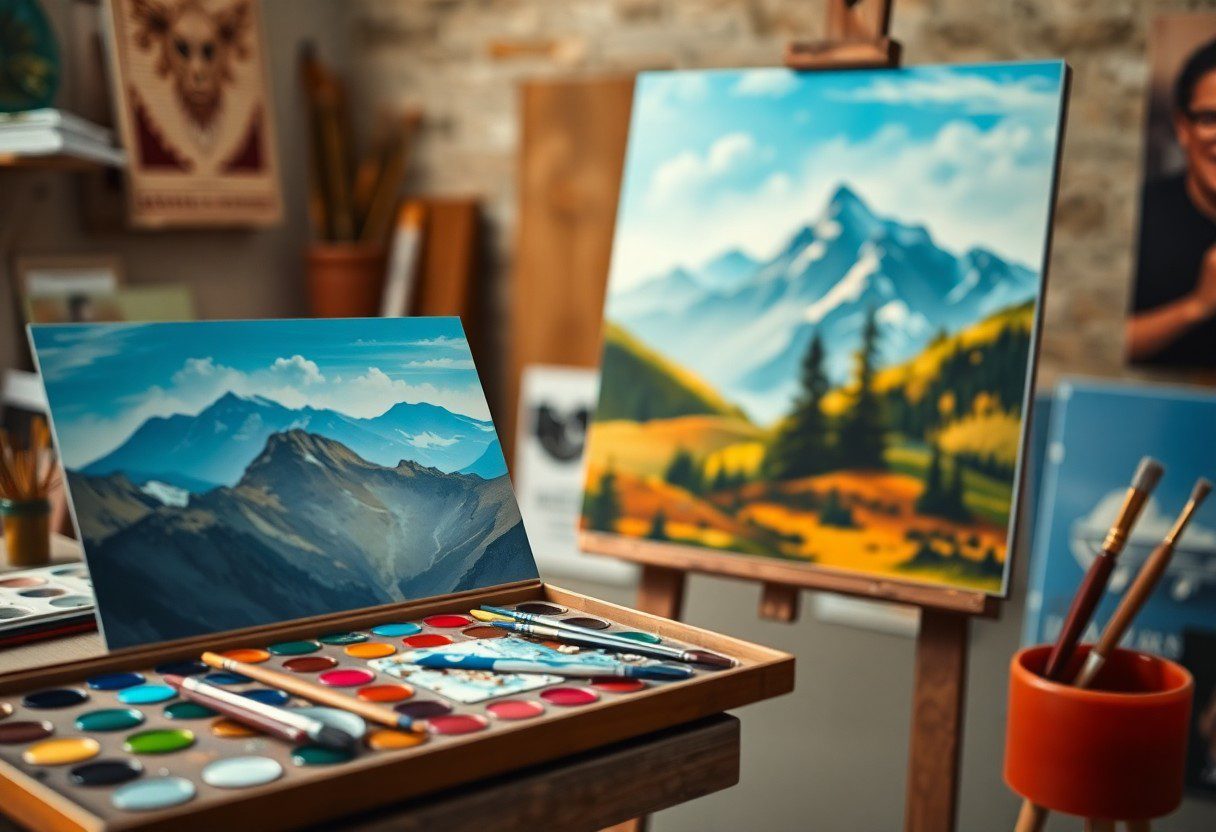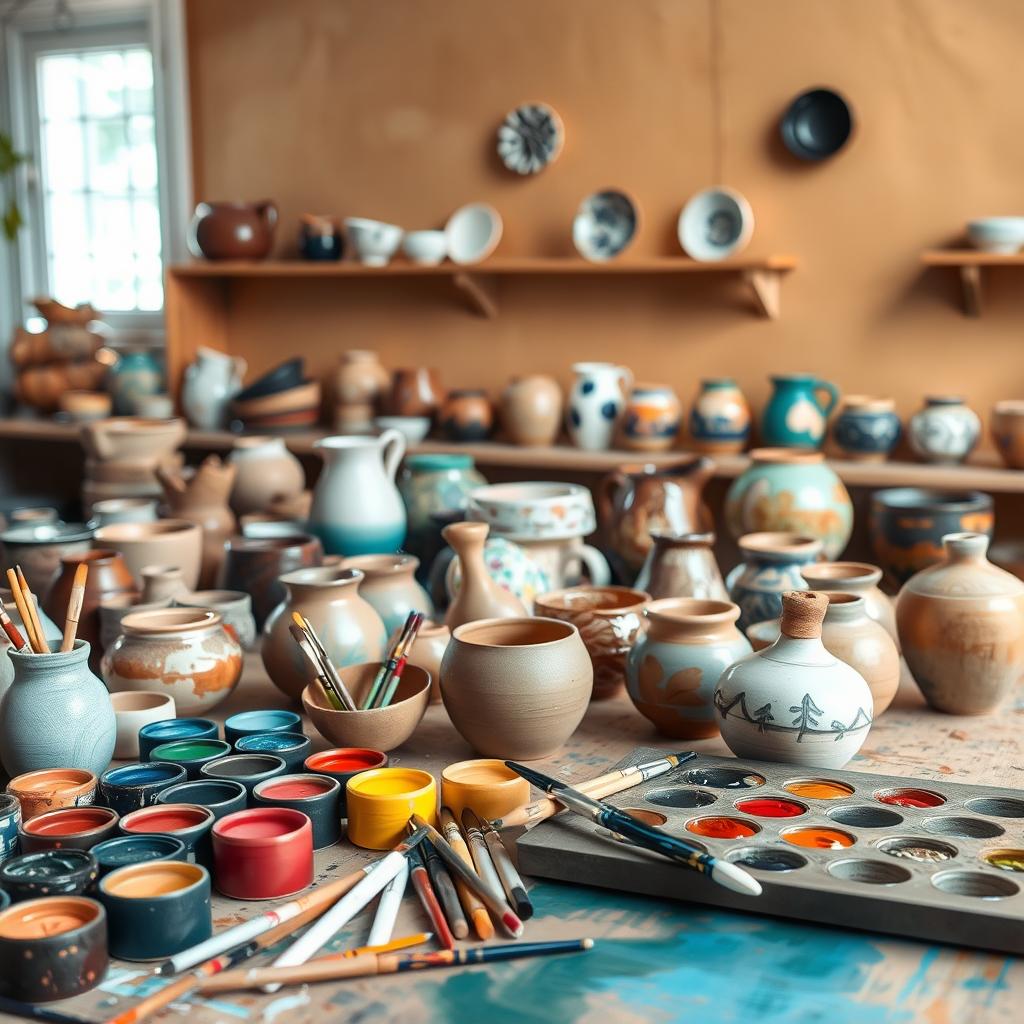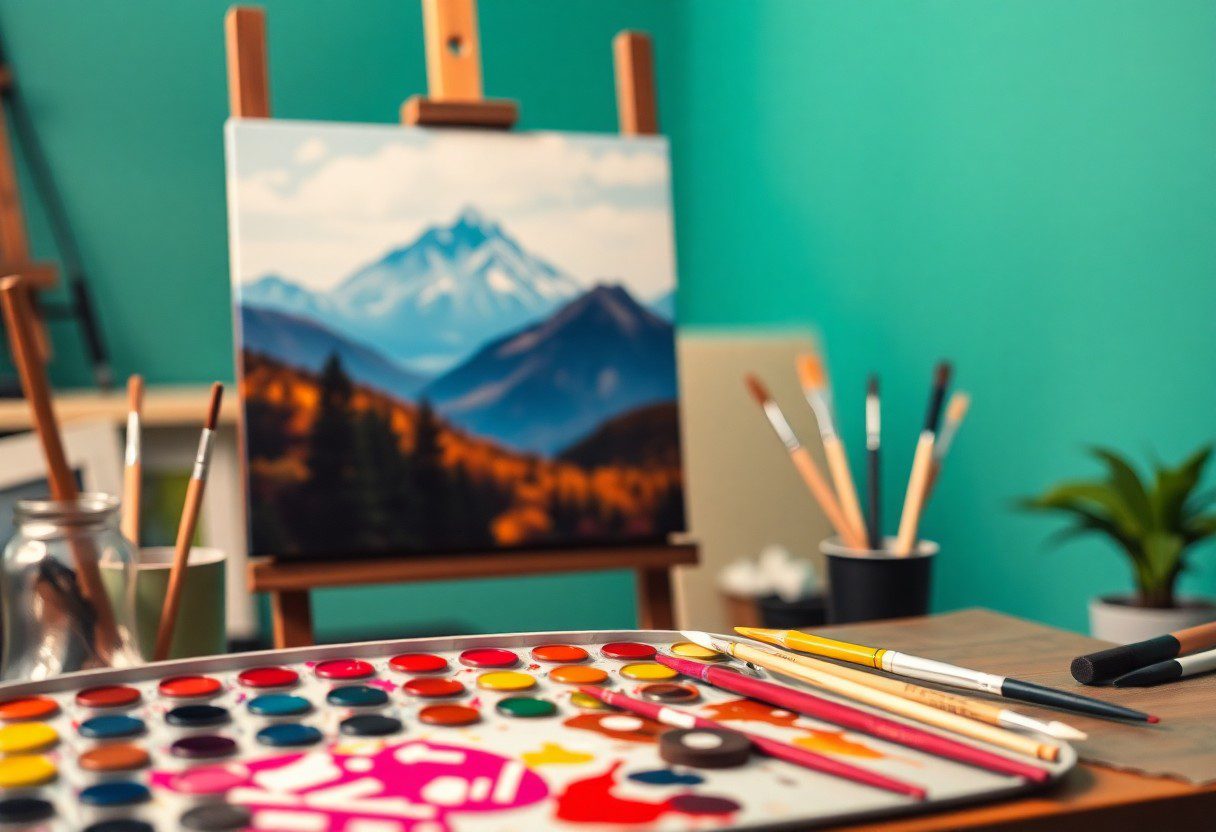Over time, the choice of paint can significantly influence the outcome of your landscape art. With a variety of mediums available, understanding their unique properties can enhance your creative process and help you achieve the desired effects. From oils and acrylics to watercolors and pastels, each medium offers distinct textures, colors, and techniques. This post will guide you through the various paint options, their benefits, and how to select the right one for your landscape projects, empowering you to express your artistic vision effectively.
Understanding Landscape Art
While exploring the beauty of landscape art, you’ll discover its unique ability to evoke emotion through visual representation. This genre captures natural scenes, often emphasizing light, color, and mood to create immersive experiences. By understanding the nuances of landscape art, you can appreciate the techniques used by artists to bring the world around us to life on canvas.
Historical Context
Between the 15th and 19th centuries, landscape art evolved significantly, influenced by changing artistic movements and societal perceptions. Initially regarded as a backdrop for historical or religious subjects, landscape painting gained prominence as techniques and styles advanced, particularly during the Romantic and Impressionist periods. This transition reflects a growing appreciation for nature and its representation in art.
Key Characteristics
One of the defining characteristics of landscape art is its focus on the natural world, often highlighting elements like terrain, vegetation, and atmospheric conditions. Artists emphasize the interplay of light and shadow, using various techniques to create depth and realism in their work.
Another key characteristic is the emotional response elicited through color palettes and composition. Artists may choose warm or cool tones to convey specific moods, inviting you into a tranquil or dramatic scene. Additionally, the arrangement of elements within the painting influences the viewer’s experience, guiding your eye through the landscape and enhancing the sense of immersion in the artwork.
Acrylic Paints
It is important to understand the versatility of acrylic paints, especially when it comes to landscape art. These paints offer a water-soluble medium that dries quickly, allowing you to layer and create textures with ease. Their vibrant colors provide depth, making them ideal for capturing the beauty of nature. Acrylics can mimic the texture of oil paints or watercolor, catering to various artistic preferences.
Properties and Benefits
Above all, acrylic paints are known for their quick drying time, which allows you to work spontaneously and build layers efficiently. They are also water-resistant once dry, ensuring your artwork remains intact over time. With a wide range of colors available, you can mix and create custom shades to match your vision, giving you complete control over your landscape compositions.
Techniques for Landscape Painting
For creating stunning landscape paintings with acrylics, several techniques can enhance your artistic expression. You can utilize blending, glazing, and dry brushing to achieve various effects, from soft skies to textured landscapes.
And as you explore these techniques, consider starting with a solid underpainting to lay the groundwork for your landscape. You can use a large brush for broad areas like skies and backgrounds, and a smaller brush for intricate details in foliage or structures. Experimenting with palette knives can add unique textures, while sponging techniques can create interesting cloud formations. Each of these methods allows you to push the boundaries of acrylic paint, inviting creativity into every stroke.
Oil Paints
If you are venturing into landscape art, oil paints offer a unique richness and depth that can transform your work. Known for their versatility and blending properties, oil paints allow you to create anything from delicate washes to bold strokes. Their slow drying time gives you the freedom to manipulate and layer colors, which is especially beneficial when capturing the nuances of light and atmosphere in your landscapes.
Advantages of Oil Paints
Any artist will tell you that oil paints come with a handful of advantages. Their vibrant pigmentation ensures that your landscapes can radiate with rich colors, while the smooth application allows you to work with precision. Oil paints also provide a longer working time, enabling you to blend and refine your artwork without the pressure of quick drying. Additionally, the texture and finish of oil paints can create a stunning depth that few other mediums can replicate.
Classic Techniques for Landscapes
At the heart of oil painting are classic techniques that have been passed down through generations. Techniques like glazing, impasto, and scumbling allow you to manipulate texture and light, creating a dynamic landscape that draws the viewer in. Each method enhances your ability to depict natural elements, such as flowing water or textured foliage, making your landscapes not only visually appealing but also evocative of the scenes you wish to convey.
Classic techniques involve various methods that enhance your artwork’s depth and richness. For instance, glazing allows you to apply thin layers of transparent color, which can alter the tone and luminosity of your landscape subtly. Impasto, characterized by thick applications of paint, creates a three-dimensional effect, while scumbling involves a lighter, dry brush technique that adds texture. Mastering these methods will help you capture the essence of nature’s beauty, translating it into evocative and enchanting works of art.
Watercolors
Your journey into landscape art can be beautifully enriched by the use of watercolors. This medium is renowned for its ability to produce soft washes and delicate hues, making it perfect for capturing the serene and ethereal qualities of natural scenery. Watercolors allow for a unique spontaneity that encourages you to be flexible and explore creative techniques, resulting in captivating landscapes full of life and movement.
Unique Qualities of Watercolor
An imperative characteristic of watercolors is their transparency, which enables you to build layers of color, offering depth and complexity in your landscape compositions. The fluid nature of the paint allows for blending and gradients that mimic the natural interplay of light and shadow, bringing your scenes to life. Moreover, watercolors can be used in both wet-on-wet and wet-on-dry techniques, giving you the freedom to experiment with different textures and effects.
Best Practices for Landscape Renderings
Along with understanding the properties of watercolors, developing effective practices can significantly enhance your landscape renderings. Start by sketching your composition lightly to establish the layout before applying paint. Use a limited palette to maintain harmony in your work, and remember to work from light to dark, layering colors gradually. Incorporating dry brush techniques can add texture and detail to specific areas of your landscape, creating a sense of realism.
For instance, begin your painting by establishing the sky with soft, diluted washes. Gradually build upon this layer to add mountains or trees, allowing for the underlayers to show through slightly. When rendering foliage, consider using a dry brush technique for added texture, which will enhance the overall visual interest of your piece. Lastly, don’t hesitate to embrace the unpredictability of the medium; some of the most striking results come from unexpected splatters or blooms in the watercolor application.
Mixed Media Approaches
Unlike traditional painting techniques that rely on a single medium, mixed media allows you to blend various materials and styles to create unique landscape art. This approach not only broadens your artistic expression but also enables you to explore innovative ways to convey depth, perspective, and emotion in your work. By combining different elements, you can achieve a level of complexity and richness that captivates the viewer’s eye, turning your landscapes into immersive experiences.
Combining Different Paints
Above all, integrating watercolors with acrylics or oils opens new avenues in your landscape art. This combination can result in a stunning interplay of transparency and opacity, allowing you to capture the delicate nuances of light and shadow. Experimenting with layering techniques can further enhance your artwork’s depth and visual appeal, transforming ordinary scenes into extraordinary landscapes.
Experimenting with Textures
Media such as sand, fabric, or modeling paste can add dimension and interest to your landscapes, making them pop off the canvas. By incorporating different textures, you create a tactile experience for the viewer and enrich the visual narrative of your piece.
The use of textured mediums in your landscape art allows you to emulate the elements of nature more realistically. For instance, applying thick layers of paint mimics the roughness of rocky surfaces, while a smooth, glossy finish can capture the serenity of a still lake. Experimenting with textures invites creativity and versatility into your artwork, enabling you to express finer details and moods that flat paint alone cannot achieve. This hands-on approach not only enhances the overall aesthetic but also makes your pieces more engaging and dynamic, inviting closer inspection and interaction from your audience.
Choosing the Right Medium
To create captivating landscape art, selecting the appropriate medium is imperative to reflect your artistic vision. Each medium, be it oil, acrylic, watercolor, or pastels, offers unique characteristics and qualities that can enhance your work. Consider how each medium interacts with light, texture, and color to make an informed decision that aligns with your artistic goals.
Factors to Consider
On your journey to choose the right medium, several factors should guide your decision-making process:
- Your level of experience with different materials
- The type of landscape you intend to depict
- Setting up your workspace and clean-up requirements
- Your desired drying times and layering abilities
Thou must weigh these factors carefully to find the best fit for your creative process.
Personal Style and Preferences
At the heart of choosing a medium lies your individual style and preferences. Each artist has a unique way of expressing themselves, and the materials you choose can significantly impact your artistic voice. Whether you lean towards the bold vibrancy of acrylics or the delicate subtleties of watercolor, your personal preference should ultimately guide your choice.
Further exploration into your personal style will help you uncover which mediums resonate with you. Engaging with various techniques and materials allows you to truly understand your strengths. Experimenting with different textures and color palettes can lead to a deeper appreciation for how each medium interacts with your artistic expression. Embrace this journey, as it will not only enhance your skills but also inform your overall approach to landscape art.
Final Words
Drawing together the various mediums available for landscape art allows you to expand your creative toolkit and discover what resonates best with you. Each type of paint offers unique possibilities, affecting the overall mood and texture of your artwork. You have the opportunity to experiment with oils, acrylics, watercolors, and more, enabling you to translate your vision of nature onto canvas in vibrant colors. Embrace this journey as you develop your artistic voice, continuously learning and adapting along the way.
FAQ
Q: What are some popular types of paints used in landscape art?
A: When considering landscape art, the most common types of paints include oil paints, acrylics, and watercolors. Oil paints are favored for their rich colors and blending capabilities, while acrylics are valued for their quick-drying properties and versatility. Watercolors provide a soft, translucent quality that can beautifully capture the essence of a landscape. Each medium has its own unique characteristics, making them suitable for different styles and techniques.
Q: How do I choose the right paint for my landscape project?
A: Choosing the right paint can depend on several factors, including your skill level, preferred techniques, and the effect you want to achieve. For beginners, acrylics are often recommended due to their ease of use and quick drying time. If you are looking for vibrant color blending and working in layers, oil paints might be your best option. For a more ethereal and flowing look, especially in depicting skies and water, watercolors are ideal. Experimenting with different types can help you find what best suits your artistic style.
Q: Can I mix different types of paints for my landscape artwork?
A: Mixing different types of paints, such as watercolors and acrylics, is generally not advised due to their varied compositions and drying times, which can lead to undesirable effects. However, some artists have successfully incorporated multiple mediums within a single piece by layering them properly. It’s best to experiment in small sections to see how they interact before applying them to larger areas of your landscape art.
Q: What tools and materials are imperative for painting landscapes?
A: Essential tools and materials for landscape painting can vary based on the paint medium you choose. For oil painting, you’ll need brushes, a palette, a palette knife, turpentine or linseed oil, and canvas. If you’re using acrylics, you’ll require brushes, a palette, water for mixing, and acrylic paper or canvas. For watercolor, you’ll need watercolor paper, brushes, a palette, and water. Additionally, a good ground or easel can provide stability during your painting process. Always consider the quality of your tools, as they significantly impact the final outcome.
Q: How can I improve my landscape painting skills using different paint mediums?
A: Improving your landscape painting skills takes practice and exploration. Start by studying the unique qualities each medium offers; for example, oil paints allow for smooth blending, while acrylics often enable vibrant layering. Create small studies or sketches before stepping into larger works to understand how each medium behaves. Attending workshops or watching online tutorials can also provide valuable insights and techniques. Lastly, always try to paint en plein air (outdoors) to observe and capture the changing light and atmosphere that landscapes present.





